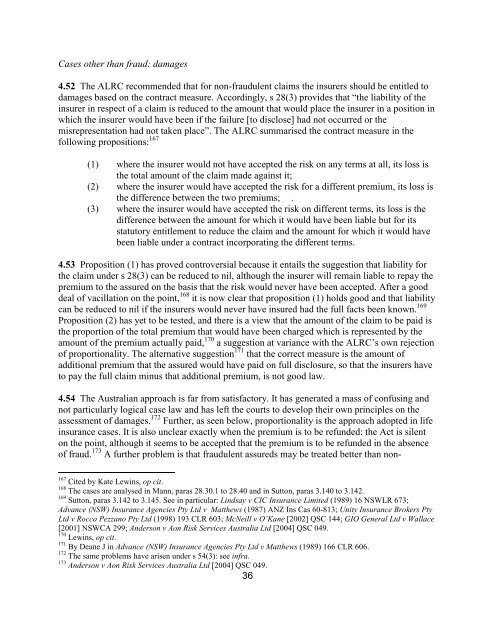REFORMING INSURANCE LAW: - Law Commission
REFORMING INSURANCE LAW: - Law Commission
REFORMING INSURANCE LAW: - Law Commission
You also want an ePaper? Increase the reach of your titles
YUMPU automatically turns print PDFs into web optimized ePapers that Google loves.
Cases other than fraud: damages<br />
4.52 The ALRC recommended that for non-fraudulent claims the insurers should be entitled to<br />
damages based on the contract measure. Accordingly, s 28(3) provides that “the liability of the<br />
insurer in respect of a claim is reduced to the amount that would place the insurer in a position in<br />
which the insurer would have been if the failure [to disclose] had not occurred or the<br />
misrepresentation had not taken place”. The ALRC summarised the contract measure in the<br />
following propositions: 167<br />
(1) where the insurer would not have accepted the risk on any terms at all, its loss is<br />
the total amount of the claim made against it;<br />
(2) where the insurer would have accepted the risk for a different premium, its loss is<br />
the difference between the two premiums; .<br />
(3) where the insurer would have accepted the risk on different terms, its loss is the<br />
difference between the amount for which it would have been liable but for its<br />
statutory entitlement to reduce the claim and the amount for which it would have<br />
been liable under a contract incorporating the different terms.<br />
4.53 Proposition (1) has proved controversial because it entails the suggestion that liability for<br />
the claim under s 28(3) can be reduced to nil, although the insurer will remain liable to repay the<br />
premium to the assured on the basis that the risk would never have been accepted. After a good<br />
deal of vacillation on the point, 168 it is now clear that proposition (1) holds good and that liability<br />
can be reduced to nil if the insurers would never have insured had the full facts been known. 169<br />
Proposition (2) has yet to be tested, and there is a view that the amount of the claim to be paid is<br />
the proportion of the total premium that would have been charged which is represented by the<br />
amount of the premium actually paid, 170 a suggestion at variance with the ALRC’s own rejection<br />
of proportionality. The alternative suggestion 171 that the correct measure is the amount of<br />
additional premium that the assured would have paid on full disclosure, so that the insurers have<br />
to pay the full claim minus that additional premium, is not good law.<br />
4.54 The Australian approach is far from satisfactory. It has generated a mass of confusing and<br />
not particularly logical case law and has left the courts to develop their own principles on the<br />
assessment of damages. 172 Further, as seen below, proportionality is the approach adopted in life<br />
insurance cases. It is also unclear exactly when the premium is to be refunded: the Act is silent<br />
on the point, although it seems to be accepted that the premium is to be refunded in the absence<br />
of fraud. 173 A further problem is that fraudulent assureds may be treated better than non-<br />
167 Cited by Kate Lewins, op cit.<br />
168 The cases are analysed in Mann, paras 28.30.1 to 28.40 and in Sutton, paras 3.140 to 3.142.<br />
169 Sutton, paras 3.142 to 3.145. See in particular: Lindsay v CIC Insurance Limited (1989) 16 NSWLR 673;<br />
Advance (NSW) Insurance Agencies Pty Ltd v Matthews (1987) ANZ Ins Cas 60-813; Unity Insurance Brokers Pty<br />
Ltd v Rocco Pezzano Pty Ltd (1998) 193 CLR 603; McNeill v O’Kane [2002] QSC 144; GIO General Ltd v Wallace<br />
[2001] NSWCA 299; Anderson v Aon Risk Services Australia Ltd [2004] QSC 049.<br />
170 Lewins, op cit.<br />
171 By Deane J in Advance (NSW) Insurance Agencies Pty Ltd v Matthews (1989) 166 CLR 606.<br />
172 The same problems have arisen under s 54(3): see infra.<br />
173 Anderson v Aon Risk Services Australia Ltd [2004] QSC 049.<br />
36

















